|
|||||||||||||||||||||||||||
|
|||||||||||||||||||||||||||
|
|||||||||||||||||||||||||||
|
|||||||||||||||||||||||||||
|
|
|
|
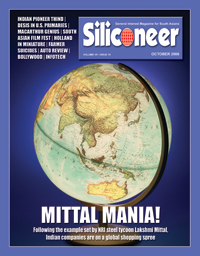
OCTOBER 2006 |
|
||
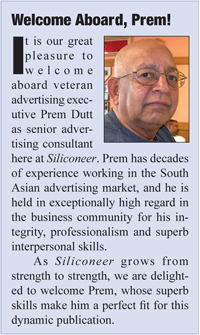 Please Join us as we welcome veteran South Asian advertising guru Prem Dutt to the Siliconeer family. Email Prem Call Prem: (510) 797-8315 |
EDITORIAL: India, Inc. Goes Global 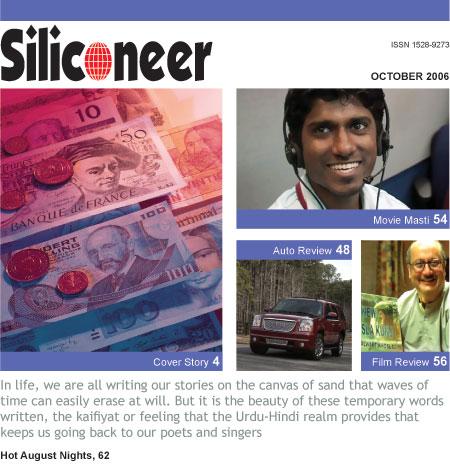 India’s economic growth and its IT and BPO prowess isn’t news anymore, but did you know that Indian big companies are now eyeing acquisitions abroad including the West? India’s economic growth and its IT and BPO prowess isn’t news anymore, but did you know that Indian big companies are now eyeing acquisitions abroad including the West? About 80 deals worth $6 billion have been sealed since the beginning of this year and global investment bankers are now wooing Indian companies more as buyers than as sellers. The Tata Group has acquired U.S.-based Glaceau, the maker of health drink vitamin water, for a cool $667 million. In February, Dr Reddy’s bought German generic drug maker Betapharm. In the UN’s foreign investment performance index rankings covering 132 economies, India has moved from 80 in 1990 to 54 in 2004. Maybe India is taking a page out of NRI tycoon Lakshmi Mittal’s copybook. Mittal recently had Western observers in a tizzy after clinching a $31 billion takeover bid for Belgian giant Arcelor Steel, making the conglomerate the biggest steel producer of the world. According to a recent report by the Boston Consulting Group, companies based in developing economies are winning in global markets. In the top 100 companies from rapidly developing economies, China (43) and India (21) have the most companies on the list, including China’s Lenovo, China National Offshore Oil Corp. and Indian information technology services giants Infosys, Tata Consulting and Wipro. Our current issue has a cover story in this by our India correspondent Siddharth Srivastava. South Asians are diffident no more: In recent U.S. primary races in September, many have thrown in their hats, and some are even winning. Nine states and the District of Columbia held primaries this year, and along with veteran lawmakers Minnesota state Sen. Satveer Choudhary and Maryland House of Delegates majority leader Kumar Barve, several newcomers have won primaries, sometimes unopposed. In Maryland, debutant Democrat Saqib Ali and Republican Dilip Paliath won enough votes to move on to the November elections. Republican Neil B. Sood of Maryland won the primary unopposed, as did Republican Jay Bala, who is eyeing a seat in the Maryland Senate. In Arizona, Rano Singh was unopposed as she sought the Democratic nomination for the state treasurer’s race. The going was tougher in New York City for two Bangladeshi Americans making a bid for state assembly nominations. Democrat Morshed Alam was convincingly beaten. Khorshed A. Chowdhury won the nomination from the Republican and Conservative Parties unopposed, but he faces a daunting challenge in November. We carry a detailed story in this month’s issue on the September primary elections. As we celebrate the growing participation of South Asians in mainstream U.S. politics today, it is worth remembering how different things were as recently as the turn of the century when early Indian pioneers came here to build a new life for themselves. Early Indian immigrants fought racial bigotry and outright hostility of the U.S. government, but they never gave up. Bhagat Singh Thind’s fight for citizenship occupies a prominent historical place in that history. An U.S. Army veteran in World War I, he got his U.S. citizenship in July 1918, but it was rescinded just four days later by the U.S. Immigration and Naturalization Service. Eleven months later, he received it for the second time but the INS appealed to the Ninth Circuit Court of Appeals which sent the case to the next higher court for ruling. Thind valiantly fought his case in the U.S. Supreme Court, but the judge revoked his citizenship simply due to the color of his skin. The court verdict in Thind’s case, United States v. Thind, was a landmark case that confirmed that the rights and privileges of naturalization were reserved for “Whites” only. Thind didn’t give up, however. After the U.S. Congress passed a law in 1935 allowing citizenship to U.S. veterans of World War I, Thind applied again and finally received his U.S. citizenship through the state of New York in 1936. We have a detailed article about him in this issue. . Do drop us a line with ideas and comments about how we can make Siliconeer better serve you. |TOP| COVER STORY: Mittal Mania! India, Inc's Shopping Spree NRI steel tycoon Lakshmi Mittal made the world sit up and take notice when he acquired venerable European steel giant Arcelor. Maybe it’s a sign of the times. According to PricewaterhouseCoopers, India Inc has recorded mergers and acquisitions in the first half of 2006 worth $25.6 billion. India has surpassed China and South Korea to grab the third position in the Asia Pacific M&A league table and is behind only Japan and Australia. This could well be the beginning of a long-term global buying spree, writes Siddharth Srivastava. 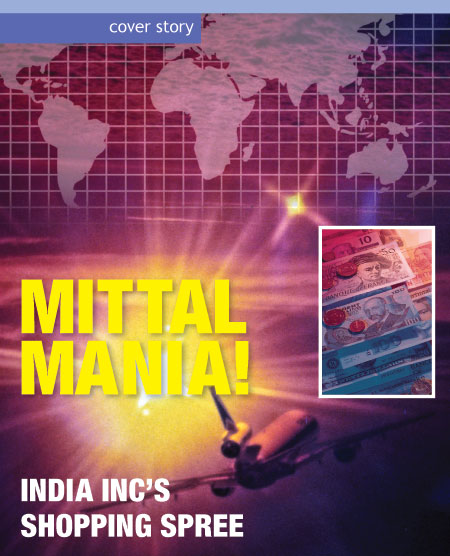 India, Inc., has been on a global shopping spree with India’s foreign direct investment outflows overtaking inflows. June this year saw the closure of 10 cross-border big-ticket deals with a combined transaction value of $1.5 billion. India, Inc., has been on a global shopping spree with India’s foreign direct investment outflows overtaking inflows. June this year saw the closure of 10 cross-border big-ticket deals with a combined transaction value of $1.5 billion. About 80 deals worth $6 billion have been sealed since the beginning of this year. The whole of 2005 saw 136 deals at a value of $4.7 billion. Global investment bankers are now wooing Indian companies more as buyers than as sellers. FDI inflows into India increased 47 percent to $1.7 billion in April-June quarter this fiscal, compared to $1.1 billion in the same period last fiscal. During 2005-2006, the FDI inflow was $ 8.2 billion. The country’s largest corporate house Tata Group has become the latest to join the ranks of Indian seekers on foreign grounds with a $677 million acquisition of U.S.-based Glaceau, the maker of health drink vitamin water, which is being pegged as the largest ever overseas buyout by a private Indian company. The deal surpasses the acquisition of German generic drug maker Betapharm by domestic pharma giant Dr Reddy’s in February this year from U.S,-based private equity firm 3i for $572 million. 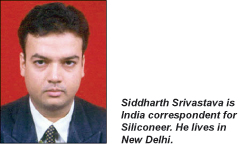 In UNCTAD’s outward FDI performance index rankings covering 132 economies, India improved its rank from 80 in 1990 to 54 in 2004. Observers say that this is the beginning of a global presence for Indian companies; some have said that India Inc is now gripped by Mittal mania. It may be recalled that India-born steel tycoon Lakshmi Mittal recently clinched a $31 billion takeover bid for Arcelor Steel, making the conglomerate the biggest steel producer of the world. In UNCTAD’s outward FDI performance index rankings covering 132 economies, India improved its rank from 80 in 1990 to 54 in 2004. Observers say that this is the beginning of a global presence for Indian companies; some have said that India Inc is now gripped by Mittal mania. It may be recalled that India-born steel tycoon Lakshmi Mittal recently clinched a $31 billion takeover bid for Arcelor Steel, making the conglomerate the biggest steel producer of the world. According to a recent report by the Boston Consulting Group, companies based in developing economies are winning in global markets, making major acquisitions, and emerging as important customers, business partners, and competitors to the world’s largest companies. In the top 100 companies from Rapidly Developing Economies, Asian companies formed 70 percent of the list. China and India have the most companies on the list, with 43 and 21, respectively. They include some obvious names, such as China’s Lenovo, China National Offshore Oil Corp. and the Indian information-technology-services giants Infosys, Tata Consulting and Wipro. Meanwhile, Indian software/BPO (at 33.6 percent) and pharma/healthcare (at 20.5 percent) sectors account for more than half of the overseas acquisitions. Major acquisitions this year were India’s largest wind energy firm Suzlon Energy acquiring Belgium’s Hansen Transmission International for $324 million. In March, pharma giant Ranbaxy also made a large foreign acquisition of $372 million, with buyout of a 96.8 percent stake in Romania’s Terapia. The largest ever acquisition by an India company abroad in the paper and pulp industry was made by Ballarpur Industries, which along with JP Morgan, acquired a 97.8 percent stake in Malaysia’s Sabah Forest Industries for $261 million. Tata’s acquisition of Glaceau only lags behind state-owned Oil & Natural Gas Corp Videsh’s 15 percent acquisition of Petrobras’ BC-10 block in Brazil for $1.4 billion. In the automotive sector, Tata Motors and Mahindra & Mahindra have adopted a mergers & acquisition strategy to become multinationals. Bharat Forge now derives substantial revenues from its overseas acquisitions. In the chemical industry, Asian Paints, Tata Chemicals, United Phosphorus and GHCL have made acquisitions in Egypt, Romania, the U.S. and the U.K. In the consumer sector, Dabur, Godrej and Tata Tea have made sizeable acquisitions. In health care, companies like Dr Reddy’s, Ranbaxy, Wockhardt, Nicholas Piramal, Jubilant and Sun Pharma are global names. Tata Coffee has acquired U.S.-based Eight O’Clock, which is around 2.5 times its size. The latest to join the bandwagon is Indian entrepreneur Raman Roy, the pioneer of business and process outsourcing in India, who may team up with 3i Group PLC to acquire U.K.-based Vertex in a deal valued at about US $600-700 million. Vertex is the outsourcing arm of U.K.’s United Utilities PLC, headquartered in Manchester with 9,000 employees across the U.K., U.S., Canada and India. According to analysts, companies are going global because they’re focused on organic growth but find that their home markets don’t have the scale or the resources to allow them to deliver the levels of shareholder value and competitive advantage they want to achieve. They aim globally to tap into new profit pools or gain long-term access to raw materials. Among the advantages the Indian (Asian) companies enjoy include lower labor cost, access to skilled manpower and ability to deliver quality at a lower price, thus offering a foreign consumer more value for money. By 2010, China and India combined will graduate 12 times the number of engineers, mathematicians, scientists and technicians as the U.S. A skilled factory worker might costs the company $1-$5 per hour, versus $20-$25 per hour in North America, Japan or Western Europe. Indeed, the overall picture reflects this trend. India’s FDI outflows as a percentage of gross fixed capital formation have risen steadily. From 0.01 percent in 1983-85, it rose 0.1 percent in 1993-95 and then to 1 percent in 2001-03. As opposed to this, China’s FDI outflow as a percentage of GFCF grew from 0.3 percent in 1983-85 to 1.3 percent in 1992-95 and then fell to 0.9 percent in 2001-03. The corresponding figures for Brazil were 0.3 percent, 0.7 percent and 0.2 percent. A survey done by Grant Thornton India in May this year suggests that corporate India is looking forward to aggressive growth through mergers and acquisitions. According to the survey, 81 percent of the 200 companies were exploring the M&A option to grow. Of the total, only 30 percent of the companies had actually undertaken any M&A in the past, indicating possibility of a sharp increase in M&A activity in the near future. According to global consultancy firm PricewaterhouseCoopers, India Inc has recorded more mergers and acquisitions in the first half of 2006 as compared to the whole of 2005. India has surpassed China and South Korea to grab the third position in the Asia Pacific M&A league table and is lagging only behind Japan and Australia. Indian companies struck M&A deals worth $25.6 billion in the first six months of 2006, up from $8 billion in the first half of 2005, and $23.6 billion for the entire 2005. The biggest portion of Indian acquisitions have been in Europe (around 40 percent) and North America (around 34 percent), highlighting Indian companies’ confidence to invest in more developed economies. A recent report published by India Brand Equity Foundation, “Going Global: India Inc in U.K.,” says that India has emerged as the third largest investor in the U.K., raising its rank by five in a single year. The biggest Indian investor in the U.K. with 16 companies employing 3,000 people is the Tata Group. |TOP|
POLITICS: Primary Colors: How South Asians Fared A good number of South Asians threw in their hats during nationwide primaries for a variety of electoral races. The going was often tough, but many South Asians are beginning at the grassroots level, a good sign. A Siliconeer report. 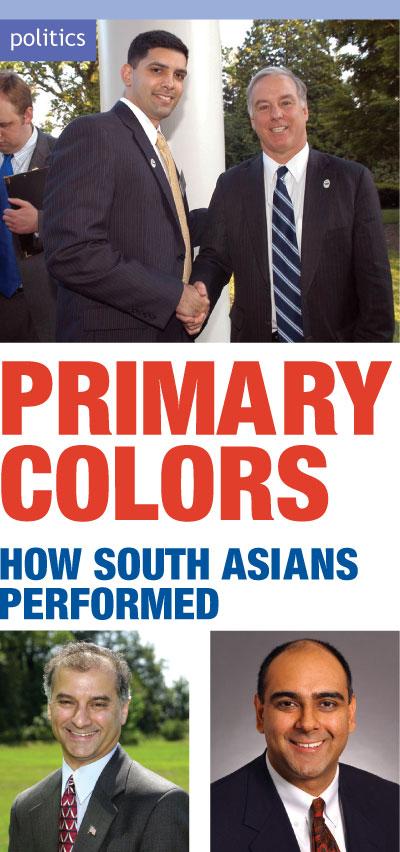 (Right): Maryland statehouse hopeful Saqib Ali (l) with Democratic leader Howard Dean; (Bottom, l): Maryland lawmaker Kumar Barve; and (Bottom, r): Minnesota state Sen. Satveer Chaudhary. Are South Asians finally waking up to the need for getting involved in mainstream politics? The signs looked good this primary season. Several newcomers joined the handful of veteran South Asian state lawmakers to try their luck in the 2006 primary season, with understandably mixed results. Nine states and the District of Columbia held party primaries on Sept. 12: Arizona, Delaware, Maryland, Minnesota, New Hampshire, New York, Rhode Island, Vermont, Wisconsin and District of Columbia. At least 11 South Asians threw their hats into various primary races in Arizona, New York, Maryland and Minnesota. For veteran state lawmakers like Minn. state Sen. Satveer Chaudhary and Md. House of Delegates Majority Leader Kumar Barve, both Democrats, the primaries were — and were expected to be — a cakewalk. In fact, Chaudhary, running for reelection from the state’s District 52, was unopposed in the primary. In 2000, he became the first Asian Indian state senator in American history. In 1996, he was elected state representative. He will take on Republican opponent Rae Hart Anderson, a health care professional, in November, and is expected to win handily. Barve, running for re-election from District 17, was first elected in 1990, and was re-elected three times in 1994, 1998, and 2002, Barve is the longest-serving elected official of Indian origin and is widely respected as an efficient lawmaker. He easily won reelection in a year when several incumbents with decades of legislative experience fell by the wayside as newcomers edged them out in Maryland. Barve of Gaithersburg, Md., and Luiz R.S. Simmons of Rockville, Md., won easily with 5,712 votes and 6,014 votes respectively. James ‘‘Jim” W. Gilchrist of Rockville took the third seat with 3,565 votes. The top three Democratic vote-getters in the primary will face three Republicans — Mary Haley, Paul N. Hnarakis and Josephine J. Wang — in the general election. For some reason, Maryland had the largest number of South Asians contesting, with five contestants in addition to Barve — Shukoor Ahmed, Saqib Ali, Nina Basu, Dilip Paliath and Neil B. Sood — running to get their party nomination to run for the statehouse. Jay Bala sought his party’s nomination to run for the state senate. Ahmed, Ali and Basu are Democrats, the others Republican. In this heavily Democratic state, winning a Democratic primary tends to be far more challenging, as it often virtually guarantees election to the statehouse. In Maryland’s District 39, debutant Saqib Ali, a 31-year-old software engineer managed the difficult feat. He edged incumbent delegate Joan F. Stern by six percent with 4,205 votes — 25.3 percent — to join incumbent delegates Charles E. Barkley (4,673 votes, 27.5 percent) and Nancy J. King (4,840 votes, 28.5 percent) to advance to the November elections on the Democratic ticket. The three nominees will run against Republicans David Nichols, Gary Scott and Bill Witham. Ali, a North Potomac, Md., resident, got an endorsements from the Washington Post. “Political newcomer Saqib Ali has shown good command of issues and would bring new vigor to this district’s delegation,” the Post wrote. Shukoor Ahmed and Nina Basu, both Democrats, lost their bids to get the Democratic nomination for the November polls. Ahmed, running from District 23A, had three competing Democrats. Two top vote getters earned the delegates’ seats, as no Republicans are contesting. Basu ran against Guy Guzzone, Shane Pendergrass, Neil Quinter and Frank S. Turner in the primary. Pendergrass (27 percent), Guzzone (25 percent) and Turner (23 percent) won to move on to the November elections. Quinter and Basu were eliminated. Quinter pulled in 17 percent of the vote and Basu tallied roughly 7 percent. 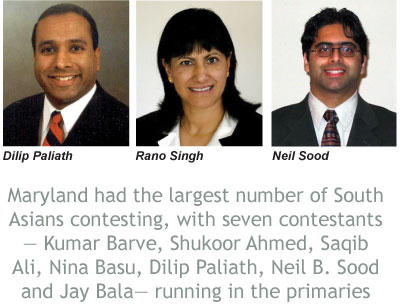 Republican Dilip Paliath won enough votes to contest the November elections while Republican Neil B. Sood won the primary unopposed, as did Republican Jay Bala, who is eyeing a seat in the Maryland Senate. Republican Dilip Paliath won enough votes to contest the November elections while Republican Neil B. Sood won the primary unopposed, as did Republican Jay Bala, who is eyeing a seat in the Maryland Senate.In Maryland’s District 42, newcomer Dilip Paliath, 35, won the third highest votes in a crowded Republican slate of eight candidates to move on to the November elections. Paliath won 2,958 votes, an almost 1,000-vote margin over his nearest competitor attorney Russ Pope (1,987 votes) to join other two top vote getters and one-term incumbents Susan Aumann (3,844) and Bill Frank (3,384). In Maryland’s District 21, Neil B. Sood, 27, was unopposed in the Republican primary for the House of Delegates. Sood will face Democratic primary winners incumbent Democrat Barbara Frush and first-time candidates Ben Barnes and Joseline Peña-Melnyk in the November elections. Sri Lanka-born Jay Bala of Waldorf, Md., won unopposed the Republican primary for state senate in Maryland’s District 28. Bala manages his wife Dr. Nirmaladevi Jayanthan’s medical practice in Waldorf. In November he will run against incumbent Sen. Thomas McLain Middleton, who has been state senator for over 10 years. In Arizona, Rano Singh was unopposed as she sought the Democratic nomination for the state treasurer’s race. In November, she will contest Republican Dean Martin. In New York City, two Bangladeshi Americans made a bid for state assembly nominations. Democrat Morshed Alam was convincingly beaten by Rory Lancman in Flushing’s open assembly seat. Khorshed A. Chowdhury won the nomination from the Republican and Conservative Parties unopposed to run for the state assembly from District 54 in Brooklyn. He faces incumbent Democratic State Assemblyman Darryl Towns, who inflicted a crushing defeat on him in 2004. |TOP| NEWS DIARY: Roundup  Benazir Speaks at San Francisco Bay Area Event | Pranab Meets NRIs | South Asian Heart Center Open House | Sweet Revenge | Bangla Rivals Meet | Berkeley Poet Receives Award from UP Chief Minister | Shashi Bows Out | ‘Walk the Talk’ | Nepal-India Treaty Held | Micro Credit to be Licensed Benazir Speaks at San Francisco Bay Area Event | Pranab Meets NRIs | South Asian Heart Center Open House | Sweet Revenge | Bangla Rivals Meet | Berkeley Poet Receives Award from UP Chief Minister | Shashi Bows Out | ‘Walk the Talk’ | Nepal-India Treaty Held | Micro Credit to be LicensedBenazir Speaks at San Francisco Bay Area Event - By Ras Siddiqui 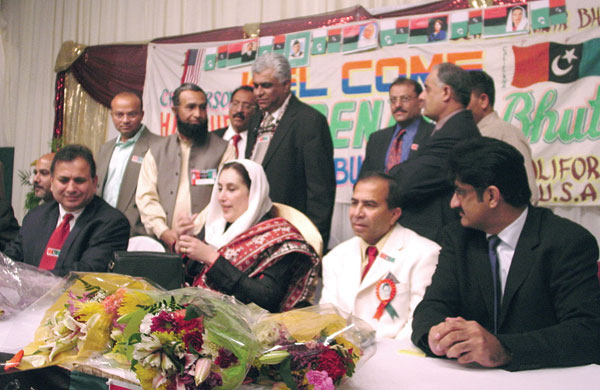 Benazir Bhutto with expatriate PPP activists. Over 500 members of the Pakistani-American community in the San Francisco Bay Area welcomed former Pakistan Prime Minister. Benazir Bhutto Sept. 29 during a breaking of the fast (Iftar) at the Chandni Restaurant in Newark, Calif. The reception was arranged by the Pakistan People’s Party, California and its visibly pleased president Khuda Bux Bhutto welcomed everyone, especially those who came from Los Angeles, Seattle and California’s Central Valley. Bhutto had a scheduled speaking engagement the day before at the Reno-Sparks area of Nevada, at the University of Nevada, Reno’s annual Foundation Banquet.
Benazir appeared to be in a somber mood. Either it was the fasting month or just plain fatigue, but she did look a little tired. Maybe it was the presence of former Congressman Pete McCloskey at this gathering and a reminder of a time when mercy petitions were being sent on behalf of her late father? Because of Pete’s presence she said a few words in English but proceeded in Urdu. She spoke about her own and her party’s victimization by the current regime in Pakistan. “How we can go and give assurances to other countries about battling extremism without having our own house in order?” she asked. She said that the PPP was unhappy with the peace treaty in Waziristan which she stressed is Pakistani territory. “The whole world is watching us. If we cannot deal with these militants ourselves then what will become of our country?” She said that the people should be (democratically) included in all decision making. She added that Pakistan is being maligned and its image has been tarnished because of these militants and that Pakistanis are being looked upon with suspicion worldwide because of them. |Back to NEWS Diary| |TOP| Pranab Meets NRIs 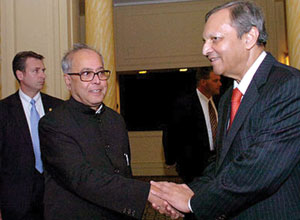 Defense Minister Pranab Mukherjee (r) shaking hands with Indian Ambassador to the U.S. Ronen Sen during a trip to New York. Defense Minister Pranab Mukherjee (r) shaking hands with Indian Ambassador to the U.S. Ronen Sen during a trip to New York.During his recent trip to New York, Indian Defense Minister Pranab Mukherjee attended a reception Sept. 24 hosted in his honor by Indian Ambassador to the U.S. Ronen Sen. As he spoke to a gathering of Indian Americans, Mukherjee said India’s essential greatness lay in its tolerance and openness. “It is indeed a matter of great pride for us that we represent a great and composite civilization that defines our ‘Indianness’ and our worldview,” he said. “Our thinking is shaped by a history in which practically all the communities of the world have thrived. India has always been a mosaic of cultures and an open society. Great religions have been born in our nation, and many from outside have been absorbed and internalized.” This tradition of tolerance continued to be reflected in contemporary India, he added. “In contemporary India, it is reflected in our commitment to secularism, which is enshrined in our Constitution,” he said. “In a world of conflict and bigotry, India provides an alternative model of peaceful co-existence. In an age in which people talk of the end of history and a clash of civilizations, Gandhi’s message is that civilizations enrich each other by overlapping and interacting.” The success of Indian Americans in the U.S., therefore, was no surprise, he suggested. “Indian Americans have the great advantage of coming from an open and pluralistic society and making another free society their home,” he said. “And openness is the basis of human creativity. Democracies sometimes seem noisy and divisive, but they are ultimately the true guarantee of unity and equitable development.” |Back to NEWS Diary| |TOP| South Asian Heart Center Open House 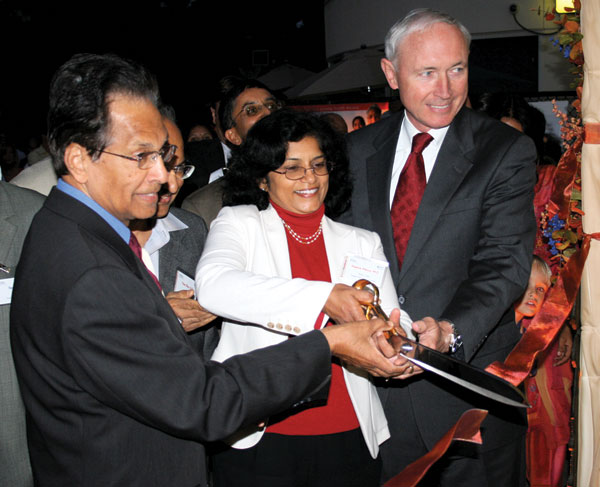 At the official opening of the South Asian Heart Center (l-r): Cardiologist Enas Enas, local gynecologist Prasanna Menon and El Camino Hospital CEO Kenneth D. Graham. The South Asian Heart Center at El Camino Hospital in Mountain View, Calif., declared itself officially open at an open house attended by over 450 people and supported by businesses and volunteers from throughout the Silicon Valley, said a center press release. Munching on “heart healthy” hors d’oeuvres, main courses, drinks and desserts supplied by some of the area’s most popular restaurants, participants were treated to tours of the facility led by 30 student volunteers from Saratoga, Monte Vista, Lynbrook, St. Francis and Harker High Schools, a signature video on the center, and an opportunity to question top heart experts about the unique cardiovascular risks faced by South Asians. In a giant tent set up for the event, the main program of the evening unfolded, emceed by Reshma Dordi, who hosts the TV show Showbiz India. Kenneth D. Graham, CEO of El Camino Hospital, welcomed participants. Gynecologist Dr. Prasanna Menon told the crowd that it was her personal experiences with her patients that led to the creation of the South Asian Heart Center. “I kept seeing so many of my patient’s families affected by this terrible epidemic,” she said. “Babies were growing up never getting a chance to know their grandparents—or even their father or mother, in some cases,” said the physician, who has practiced 25 years and delivered 4,000 babies. The honor of ribbon-cutting went to world-renowned cardiologist Dr. Enas Enas, a Chicago-area doctor whose cutting edge research on South Asian heart disease has helped form the foundation of the South Asian Heart Center’s unique program, which includes advanced screening that goes beyond conventional blood tests in addressing emerging risk factors unique to South Asians. The SAHC is the first nonprofit organization in the world to address the prevention of the global epidemic of heart disease affecting people of South Asian descent (from the countries of Bangladesh, India, Nepal, Pakistan, and Sri Lanka). More information is available at: www.southasianheartcenter.org |Back to NEWS Diary| |TOP| Sweet Revenge 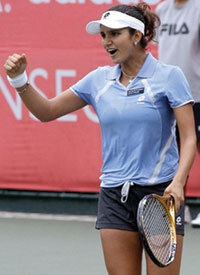 Indian whiz Sania Mirza celebrates after beating former world tennis champion Martina Hingis at the Korea Open. Indian whiz Sania Mirza celebrates after beating former world tennis champion Martina Hingis at the Korea Open.India’s Sania Mirza rallied past top seed Martina Hingis 4-6 6-0 6-4 in the second round of the Korea Open Sept. 28, gaining quick revenge on the former number one for a defeat in Kolkata last week. After losing the first set in which both players struggled to hold serve, Mirza raised her level of play and was able to push the Swiss world number eight around the court with her powerful groundstrokes. Easing through the second without dropping a game, the world number 59 broke her opponent in the ninth game of the deciding set and held on to deny Hingis a chance of a third title this season. Hingis beat Mirza in the semi-finals on her way to a Kolkata Open victory earlier to go with an Italian Open success earlier this year. The 25-year-old five-time grand slam winner retired in 2002 due to foot and ankle injuries, but made a full-time comeback in January. However Mirza went on to lose in the quarterfinal. |Back to NEWS Diary| |TOP| Bangla Rivals Meet 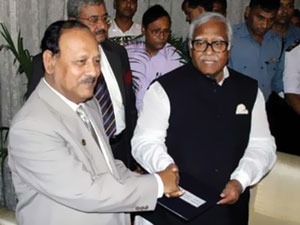 Bangladesh ruling party BNP secretary Abdul Mannan Bhuiyan (l), receives his counterpart Abdul Jalil of opposition Awami League. Bangladesh ruling party BNP secretary Abdul Mannan Bhuiyan (l), receives his counterpart Abdul Jalil of opposition Awami League.Leaders of the governing party of Bangladesh and the main opposition party have met to discuss their disagreements over electoral reforms. The secretary general of the ruling Bangladesh Nationalist Party agreed to attend the meeting with his counterpart from the opposition Awami League. The date was fixed in a telephone conversation between the two politicians. “The dialogue will be held tomorrow at the Jatiya Sangsad [national parliament],” Bangladesh Nationalist Party Secretary General Abdul Mannan Bhuiyan told reporters earlier at his official residence. “I have spoken to Abdul Jalil [secretary general of the Awami League] - and the time and venue have been set.” The announcement brings an end to growing speculation and confusion about the timing of a meeting. Bhuiyan earlier refused to meet his Awami League counterpart at the residence of the U.S. ambassador in Dhaka, Patricia Butenis. He argued that the premises of a foreign country should not be used to resolve domestic political disputes. The Awami League and its allies insist they must have a say in choosing the head of the next caretaker administration, which will oversee the general election due in January. |Back to NEWS Diary| |TOP| Berkeley Poet Receives Award from UP Chief Minister 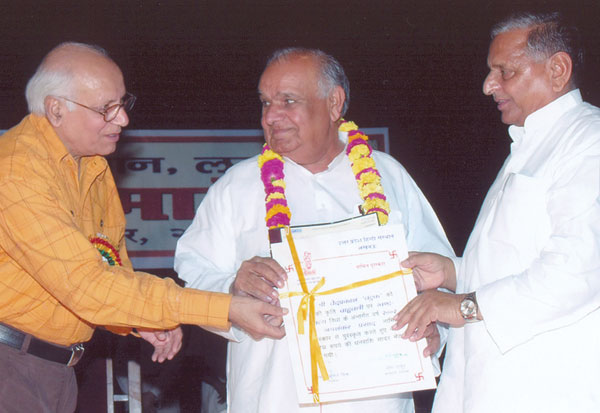 Berkeley, Calif.,-based poet and folklorist Dr. Ved Prakash Vatuk (c) being presented the Jaishankar Prasad Award for his epic “Bahubali.” Also seen: Som Thakur (l), Vice President of the Hindi Sansthan and Uttar Pradesh Chief Minister Mulayam Singh Yadav. Berkeley, Calif.,-based poet, folklorist and peace activist Ved Prakash Vatuk recently received he Jaishankar Prasad Award for his epic poem “Bahubali.” The award, which is conferred by the Uttar Pradesh government’s Hindi Sansthan, recognizes the best epic of the year. It carries a citation and a cash prize of Rs. 25,000. The award ceremony was held on Hindi Diwas, Sept. 14. Writing about his epic in an earlier issue of Siliconeer, Vatuk wrote: “Briefly, what I want to say is this: Today, as man stands on the brink of global destruction, his hunger for power makes him refuse to face up to what he already knows. The tendency to resolve every conflict with brute force and violence, borrowed from an older, barbaric age, is still with us. The world’s self-centered rulers still fail to realize that if they do not cease to use violent force to resolve every problem, one day they themselves will become the fuel in the yagna for power. “In the context of these questions I wrote ‘Bahubali,’ a story in verse — a khanda-kavya — borrowing a unique story form a myth from ancient Indian history. This story is about Bharat and Bahubali — the two sons of the apostle of non-violence and peace, the adi tirthankar Rishavdev. The elder brother Bharat, the ruler of Ayodhya, girded his loins to conquer the world in the name of world peace and found the Chakravarty rajya. However, his younger brother Bahubali, the ruler of Podanpur, considered sacrificing the lives of his subjects to protect his kingdom a policy preferable to accepting the primacy of his elder brother. The battle between these two feuding brothers could have been as horrific as the war in Mahabharat, had not the blameless subjects and its leaders stood up to protest the imminent bloodshed of the innocent in the impending dharmyuddh. This message of the pointlessness of war and lust for power, and the proposal of an alternative, nonviolent society — this is the essence of my poem.” |Back to NEWS Diary| |TOP| Shashi Bows Out 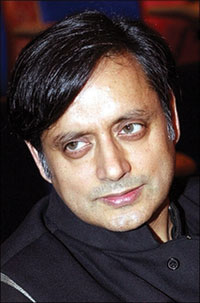 Shashi Tharoor Shashi TharoorIndia’s candidate for the post of UN secretary general, Shashi Tharoor, says he is “disappointed” after coming second again in informal polling. A career diplomat, Tharoor pulled out of the race after South Korea’s Ban Ki-Moon won the latest straw poll. Although Tharoor got 10 votes, one more than needed to stay in the race. one of the three negative votes was from a permanent Security Council member. A formal vote to choose the secretary general is due Nov. 9. Tharoor said he had “entered the race because of my devotion to the United Nations, and for the same reason I will strongly support him as the next secretary general. The UN, and the world, has a stake in his success.” Although he has conceded victory, Tharoor is “disappointed” by the result. In an interview to the BBC, he said, “I have spent 28 years working for the UN. All the other candidates have worked for their governments. I was the only candidate who has devoted my entire professional life to the UN and worked for the international community.” Tharoor thanked the Indian government for supporting his candidacy. |Back to NEWS Diary| |TOP| 'Walk the Talk' 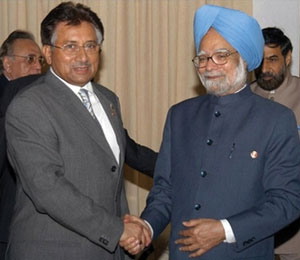 Pakistani President Pervez Musharraf (l) shakes hands with India’s Prime Minister Manmohan Singh. Pakistani President Pervez Musharraf (l) shakes hands with India’s Prime Minister Manmohan Singh.Pakistan has to prove it is sincere about working with India to counter terrorism, Prime Minister Manmohan Singh warned after police accused Islamabad of plotting blasts that killed 186 commuters in India’s financial capital Mumbai. “Pakistan will have to walk the talk,” to back up its promise to cooperate on terrorism, Singh told reporters. “Whatever has been discovered (by Mumbai police), we shall share that information with Pakistan and test them on how sincere they are in carrying forward the commitment I and President (Pervez) Musharraf have underlined,” Singh said on his plane trip home from South Africa. Mumbai police chief A.N. Roy publicly accused Pakistan’s spy agency, the Inter Services Intelligence, of orchestrating the July attacks on trains that also wounded 800. Pakistan has pledged to take action if India produces evidence to show that ISI was involved in the Mumbai bombings, but has denied any role in the attacks. India froze peace talks with Pakistan in the aftermath of the attacks but agreed to continue the dialogue after a meeting between Singh and Musharraf in Havana Sept.16. The leaders decided to “put in place an India-Pakistan anti-terrorism institutional mechanism to identify and implement counter-terrorism initiatives and investigations.” When asked how the proposed counter-terrorism mechanism would work, Singh said: “We have set up this mechanism. How else can we ask for information except through a mechanism like this?” “The mechanism is yet to take off,” he said. But once it does, “then we will test the waters,” Singh said. He added that the peace process cannot “move forward until both countries sincerely work to gain mastery over this menace.” |Back to NEWS Diary| |TOP| Nepal-India Treaty Held 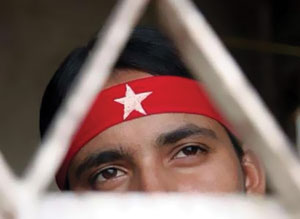 A Nepal Communist Party Maoist’s student activist A Nepal Communist Party Maoist’s student activistA demand from Nepal’s Maoists has caused the postponement of this week’s signing of an extradition treaty between Nepal and India, a television report said. Maoist leader Pushpa Kamal Dahal, better known as Prachanda, telephoned Nepalese Prime Minister Girija Prasad Koirala to demand that the governing Seven-Party Alliance not sign the treaty without the participation of the Maoist rebels, the Kantipur Television reported. Kantipur Television quoted highly placed Maoist sources as saying Koirala agreed to the Maoist request to postpone the signing of the treaty that was agreed upon earlier this year until a more representative government was in place in Nepal. Nepalese Home Minister Krishna Prasad Sitaula had been scheduled to leave for New Delhi to sign the treaty. It is to replace an extradition treaty that Nepal and India signed in October 1953. India wanted to revise it, saying the 1953 document was not adequate to deal with the modern-day problems of drug and human trafficking along the countries’ 1,700-kilometre-long border. Government sources said Koirala agreed to put off the signing of the revised extradition treaty until after top-level peace talks scheduled for Sunday between the leaders of his ruling alliance and the Maoists, who have been waging a civil war for a decade. |Back to NEWS Diary| |TOP| Micro Credit to be Licensed 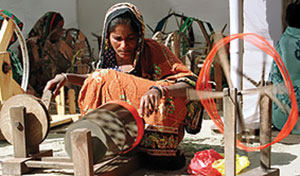 A Bangladeshi woman spins on a wheel provided by micro-credit. A Bangladeshi woman spins on a wheel provided by micro-credit.Authorities in Bangladesh have been strongly considering a proposal for mandatory license for all the organizations operating micro-credit schemes for the poor section of the people. Officials at the Bangladesh central bank, Bangladesh Bank, say that the institutions, both in public sector and non-governmental organization, must apply for the licenses or a certificate from the Micro-credit Regulatory Authority by February 2007. “Any institution, existing and new ones, will have to obtain the license to operate micro-credit programs,” Salehuddin Ahmed, the chairman of the regulatory authority and governor of the Bangladesh Bank, told newsmen after the first meeting of the authority. For operations of micro-credit programs, lives have apparently changed in rural Bangladesh, and to many extents the programs helped poverty reduction. Bangladesh’s micro-credit programs introduced by Grameen Bank of Mohammad Yunus is being introduced in many countries in the world. The Bangladesh Bank governor said that the authority would decide the size of the registration fees later. Each application form will cost Tk 500. The regulatory body will examine the applications once they are submitted and also review the overall performance of the micro-credit institution. It will evaluate the managerial capacity, capital adequacy, area of activities and reputations of the sponsors. Based on the evaluation the authority would issue the certificate. Without such certificate or licensing no organization will be allowed to operate micro-credit business in Bangladesh, officials said. |Back to NEWS Diary| |TOP| |